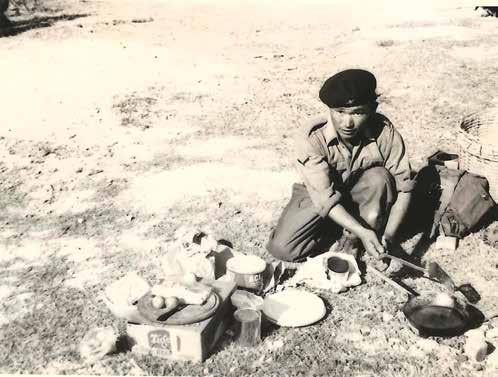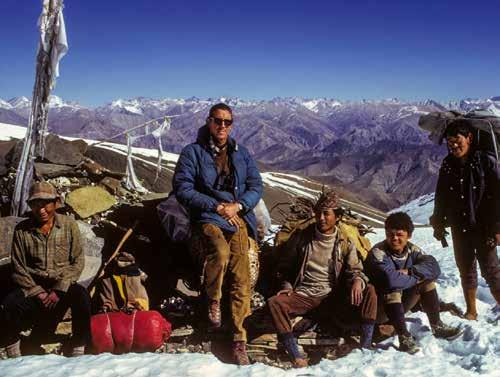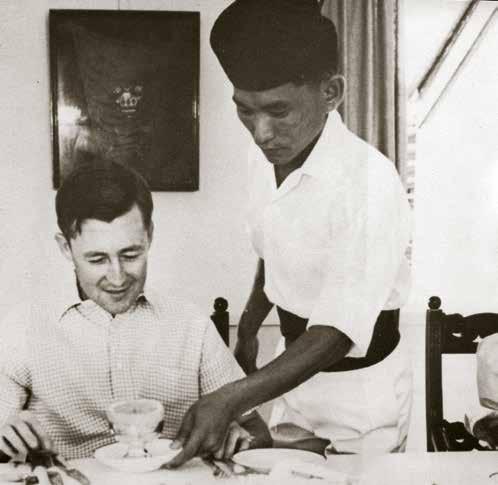
6 minute read
Who was Thukte Sherpa?
from 6 GR Journal 100
“In his life in the moment, in his freedom of attachments, in the simplicity of his everyday example, Tukten has taught me over and over, he is the teacher that I’d hoped to find… “When you are ready,” Buddhists say, “the teacher will appear.”
Peter Matthiessen, The Snow Leopard, Viking Press, 1978, p. 316.
Ihope you agree that the this request! As it happened, above is a very impressive he was a great choice. He was accolade for anyone, let always popular with the British alone a humble Lance Officers, very cheerful, with a wide Corporal, from an award-winning ready smile. author, and is the main reason that prompted this article. What had we The other mess waiter for the 2/6th all missed about Thukte? was Desmond’s orderly, Tekbahadur Pun. The two for the 1/6th were In the 1960s, Matthiessen, who Kalusing Gurung and Rambahadur had lived with the Amazonian Thapa. Kalusing became a tribes of Brazil, and taken their renowned “joker” and dancer in the “spiritual medicine”, ayahuasca, 1/6th for which I got much credit introduced his wife Deborah to LSD from his CO Gil Hickey. and other hallucinogens. She in turn had given him the rudiments However, Thukte was a bit of of Zen Buddhism and this became Thukte Sherpa, Nepal, 1962 an outsider in the 6 GR Gurung/ his primary study for the remaining Magar environment and he found 40 years of his life. He eventually became a Zen it very difficult, when made a Lance Corporal, to get monk and established a Zen Buddhist retreat on Long others to work for him given their view of his jhat and Island NY. status. Regrettably he subsequently volunteered for redundancy and was discharged on 15 March 1970. The Snow Leopard describes a journey Matthiessen made with the naturalist George Schaller in 1973 to Soon after his discharge Thukte was hired for the Dolpo Region of Nepal. Bonington’s Annapurna expedition. The other Sherpa was Ang Pema. Of the two Sherpas, Bonington wrote: Some 18 months after joining the 2/6th I was sent to Nepal to help recruit the 1,700 strong 1962 Galla. “Ang Pema was invaluable as a high-altitude This was the largest post war intake of recruits porter while Thukte was a superb chef and major and replaced those who enlisted in 1947. Although domo. He was well built but lacked the inherent persons much more expert than I carried out most toughness of the successful high-altitude porter”. of the recruiting I was given the specific task of recruiting four mess waiters, two for each Battalion. Bonington’s observations provided some clues to One of these was Thukte Sherpa. Thukte’s origins. Throughout his life he claimed to be from the Khumbu region, but his inability to succeed Thukte arrived in Dharan with a message from at very high altitude indicates that Thukte was born at George Lorimer for Desmond Huston that he might a much lower altitude than Ang Pema. He was from make a good mess waiter. I could hardly turn down the Khumbu region, at 13,000 feet above sea level,
Thukte cooking breakfast on the Ranges in Hong Kong not so much that this man and I are friends. Rather,
near the foot of Mt. Everest. Thukte had a Sherpa name, but not necessarily Sherpa lungs.
I discovered many years later that Thukte was born in Tibet and crossed over to Nepal some time on or after 1950 aged about 10, when thousands of Tibetans were pouring over the passes into Nepal to escape the horrors of the Chinese “liberation” of Tibet. A family named Xangbu in Khunde, headed by Ang Dorje and Ang Bhuti, with three brothers and two sisters, adopted Thukte.
At this stage you might say “so what”? The reason being that Kathryn (Kate) O’Hehir, a Zen Buddhist article she had written about Thukte. His part in The Snow Leopard, like me, had prompted her article, and the extracts below shows Peter Matthiessen’s close empathy with Thukte (whom he called Tukten). In the rear window of the cab, Tukten is ghostly; I stare after him as he withdraws into the dusk. It is
from Arizona, contacted me in 2004 about a long there is a thread between us, like the black thread of a live nerve; there is something unfinished, and he knows it, too. Without ever attempting to speak about it, we perceive life in the same way, or rather, I perceive it in the way that Tukten lives it. In the way he watched me, in the way he smiled, he was awaiting me; had I been ready he might have led me far enough along the path ‘to see the snow leopard’. 1
Later Matthiessen goes on to say:
At supper, the Sherpas, in good spirits, include me as best they can in their conversation, but after a while I bury myself in these notes, so they can talk comfortably amongst themselves. Usually this
George Schaller

Thukte (left), Peter Matthiessen and other Sherpa staff, at the top of the Saldang Pass east of Shey, Upper Dolpo, December 1973
means listening to Tukten, who holds the others rapt for hours at a time with that deep soft voice of his, his guru hands extending in a hypnotizing way over the flames. I love to watch our evil monk with his yellow Mongol eyes and feral ears, and it is rare that I look at him when he isn’t watching me. 2
O’Hehir wanted to know how Thukte had died and more about his army service. I was able to do this in some detail.
Like many others who went on redundancy Thukte did not qualify for a pension but a lump sum equal to six months’ pay. I had complained at the time to HQBG that this was a mistaken policy, as the money would become destitute. Sure enough this happened to Thukte, compounded by the fact that he contracted TB. A pension no matter how small would at least have meant he could have fed himself.
In December 1982, Duncan Briggs went on trek to Nepal, and while in Kathmandu was informed by the Transit Camp Gurkha Major, Manbahadur Tamang, that Thukte was at Swayambunath and dying of TB. He then set off with a young Adrian Griffith on bicycles to try to find him. They finally did find him in one of the pretty grim “hostels” surrounding Swayambunath and he certainly was in a poor way. would soon run out, and without employment many
With the help of Manbahadur, Duncan arranged for him to get medical treatment, but it transpired that his TB was so far advanced it was too late to save him.
When I received this information in Brunei I was able to get Thukte admitted to BMH Dharan. He did not

Thukte serving Evan Powell-Jones a traditional Mess breakfast
last long, but I am very glad that our intervention enabled Thukte to spend his last days in relative comfort and dignity, and that he received the necessary medical care to minimise his suffering.
Had we all missed something about Thukte that Matthiessen divined? I do not think so. Matthiessen’s journey to the Himalayas came at a moment in his perhaps, solace. His second wife, Deborah Love, had died 20 months earlier, at the age of 44, from a sudden and quickly spreading cancer. Maybe this was the reason why he saw Thukte as “The teacher that I’d hoped to find”?
I am sure most of you who knew him, will remember him more as an ever-cheerful and willing Mess waiter. life when his mind was desperate for clarity and,
This is well demonstrated in this photo of him serving Evan Powell-Jones a ‘rumble tumble’ breakfast in the Kluang Mess in 1967. RIP Thukte, whoever you were.










